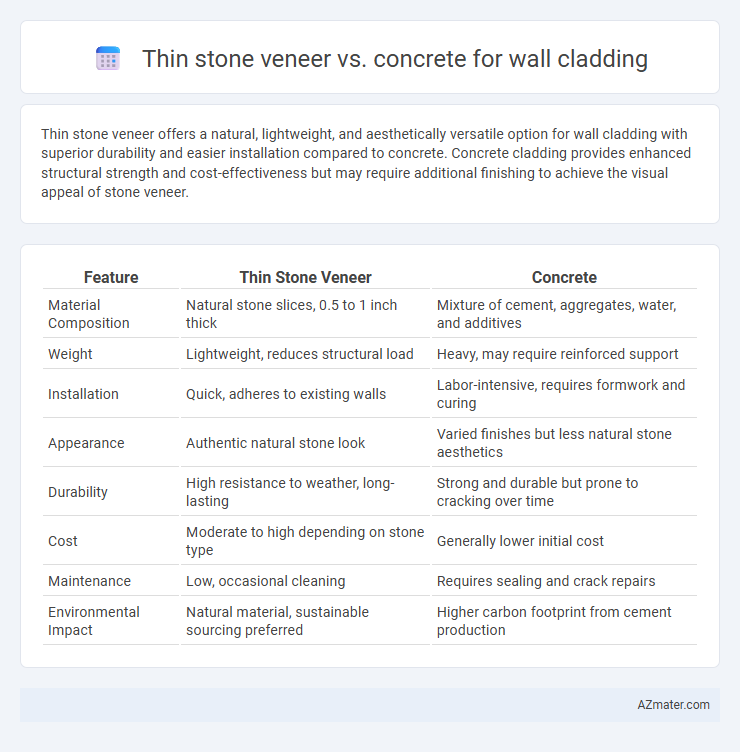Thin stone veneer offers a natural, lightweight, and aesthetically versatile option for wall cladding with superior durability and easier installation compared to concrete. Concrete cladding provides enhanced structural strength and cost-effectiveness but may require additional finishing to achieve the visual appeal of stone veneer.
Table of Comparison
| Feature | Thin Stone Veneer | Concrete |
|---|---|---|
| Material Composition | Natural stone slices, 0.5 to 1 inch thick | Mixture of cement, aggregates, water, and additives |
| Weight | Lightweight, reduces structural load | Heavy, may require reinforced support |
| Installation | Quick, adheres to existing walls | Labor-intensive, requires formwork and curing |
| Appearance | Authentic natural stone look | Varied finishes but less natural stone aesthetics |
| Durability | High resistance to weather, long-lasting | Strong and durable but prone to cracking over time |
| Cost | Moderate to high depending on stone type | Generally lower initial cost |
| Maintenance | Low, occasional cleaning | Requires sealing and crack repairs |
| Environmental Impact | Natural material, sustainable sourcing preferred | Higher carbon footprint from cement production |
Introduction to Wall Cladding Options
Thin stone veneer offers a natural, lightweight, and aesthetically rich solution for wall cladding, replicating the appearance of full-thickness stone while reducing structural load. Concrete cladding provides a durable, cost-effective alternative with superior versatility in shapes, textures, and finishes, suitable for both modern and industrial designs. Choosing between these options depends on factors such as budget, installation requirements, desired appearance, and maintenance considerations.
What is Thin Stone Veneer?
Thin stone veneer is a natural or manufactured stone material cut into thin slices, typically ranging from 0.5 to 2 inches thick, designed specifically for decorative wall cladding. It offers the authentic appearance of full-thickness stone while being lighter and easier to install on various surfaces compared to concrete panels. This veneer provides superior aesthetic appeal, breathability, and natural texture, distinguishing it from the uniformity and weight of concrete cladding options.
Understanding Concrete Wall Cladding
Concrete wall cladding offers superior durability and weather resistance compared to thin stone veneer, making it ideal for exterior applications requiring long-term performance. Its versatility allows for various finishes, textures, and colors, enabling custom aesthetic options that blend functionality with modern design. Concrete also provides enhanced insulation and fire resistance, contributing to energy efficiency and safety in building construction.
Aesthetic Differences: Stone Veneer vs Concrete
Thin stone veneer offers a natural, textured appearance with varied color tones and organic patterns that enhance wall cladding aesthetics, creating a warm and rustic ambiance. Concrete cladding provides a sleek, uniform surface with customizable finishes, including smooth, polished, or stamped designs that deliver a modern and industrial look. While stone veneer emphasizes natural beauty and timeless appeal, concrete excels in versatile styling and contemporary architectural expression.
Durability and Longevity Comparison
Thin stone veneer offers superior durability due to its natural stone composition, which resists weathering, chipping, and fading over decades. Concrete cladding, while strong and versatile, may be prone to cracking and requires regular maintenance to prevent moisture infiltration and surface degradation. Overall, thin stone veneer provides longer-lasting aesthetic and structural performance compared to concrete in wall cladding applications.
Installation Processes and Challenges
Thin stone veneer offers lightweight installation, often requiring metal lath and mortar adhesion, which suits uneven surfaces but demands precision to prevent cracking and ensure durability. Concrete cladding involves formwork and curing time, typically requiring skilled labor for proper mixing, pouring, and finishing to avoid issues like surface shrinkage or improper bonding. Both materials present challenges in moisture management and structural support, making careful substrate preparation essential for long-term performance.
Cost Analysis: Initial and Long-term Investment
Thin stone veneer offers a higher initial cost compared to concrete due to material and installation expenses but provides long-term value through durability and minimal maintenance. Concrete cladding requires a lower upfront investment and faster installation but may incur higher long-term costs from repairs and weather-related wear. Evaluating total cost of ownership reveals thin stone veneer as a cost-effective choice for projects prioritizing longevity and aesthetics.
Environmental Impact and Sustainability
Thin stone veneer offers a more sustainable option for wall cladding due to its natural composition and lower embodied energy compared to concrete, which requires significant energy for cement production and emits high levels of CO2. Stone veneers are often sourced locally, reducing transportation emissions and minimizing environmental degradation, whereas concrete relies heavily on non-renewable resources and has a larger carbon footprint. Additionally, thin stone veneer can be recycled or reused more easily than concrete panels, enhancing its overall environmental benefits.
Maintenance Requirements for Both Materials
Thin stone veneer demands minimal maintenance, requiring occasional cleaning and resealing every 3 to 5 years to prevent moisture intrusion and preserve appearance. Concrete wall cladding may require more frequent inspections for cracks and periodic sealing to protect against weathering and efflorescence. Both materials benefit from routine cleaning, but concrete's susceptibility to surface damage necessitates a more proactive maintenance regime.
Choosing the Best Material for Your Project
Thin stone veneer offers natural aesthetics, durability, and lightweight installation, making it ideal for enhancing visual appeal without adding significant structural load. Concrete wall cladding provides superior strength, cost-effectiveness, and versatility in design, suitable for projects requiring robust weather resistance and low maintenance. Evaluating factors such as budget, desired texture, structural requirements, and climate conditions helps determine the best choice for your specific wall cladding needs.

Infographic: Thin stone veneer vs Concrete for Wall cladding
 azmater.com
azmater.com